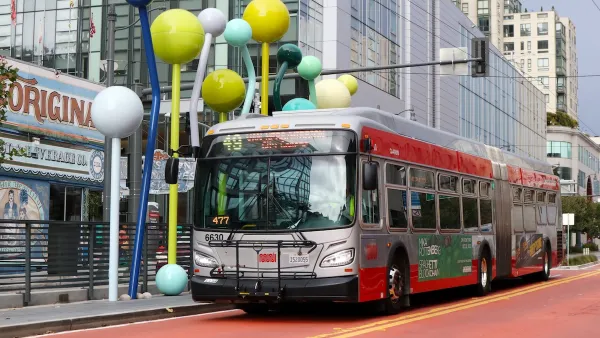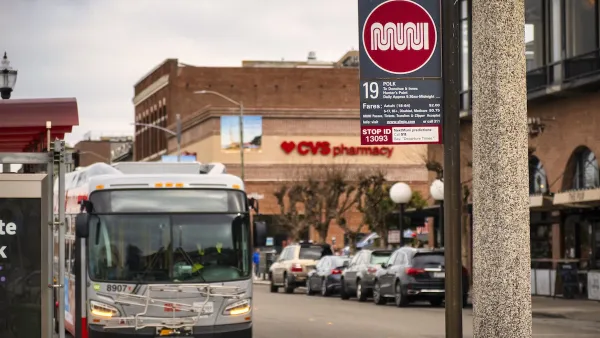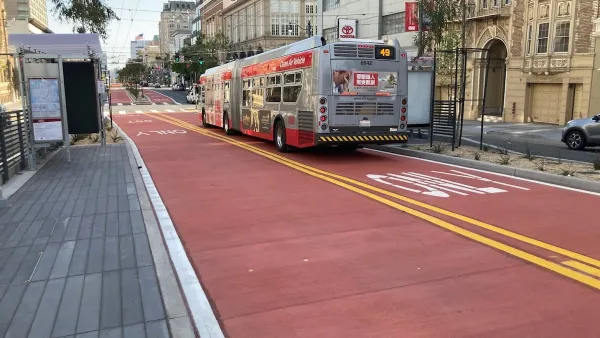Sharrows are a great way to give cyclists access to the full traffic lane without designating a bike lane, but as this case in San Francisco illustrates, not all applications are good ones. The presence of a bus-only lane created the problem.
Sharrows, or 'shared lane' signage, are applied on traffic lanes to clearly mark these lanes to cyclists and motorists that both have access to them. Generally they are used on narrow curb lanes where vehicle parking exists to prevent cyclists from biking to closely to the parked cars so as to prevent being 'doored'. However, the far-right, bus-only lanes on Post and Sutter made that impossible, so the San Francisco Municipal Transportation Agency (SFMTA) chose to sharrow the center lane as cyclists are not legally allowed to use lanes exclusive to buses.
"On two main thoroughfares in and out of downtown - Post and Sutter Streets between Van Ness Avenue and Union Square - the transportation agency has placed (sharrows) in the middle of busy, one-way streets. This puts cyclists in the center lane of three, surrounded by fast cars on all sides.
Joshua Citrak, an avid cyclist with 10 years' experience on San Francisco streets, pedaled the route at the request of The Bay Citizen." See his excellent video of biking the hills in urban San Francisco.
From Streetsblog SF (6/25/10): New Sharrows on Sutter and Post Streets Not Popular with Cyclists
New sharrows have been placed on the center lanes of Post and Sutter, but "drivers often zoom by at alarming speeds, breaking the 25 mile an hour speed limit, narrowly avoiding crashes, and treating the three-lane arterial like a highway...
The SFMTA recently installed the sharrows on both Sutter and Post Streets (Bicycle Route 16) as part of its Bike Plan directive to add 75 miles of new sharrows on bike routes across the city."
Thanks to SF Streetsblog
FULL STORY: New San Francisco Bike Lanes Too Dangerous to Use (Plus: Video)

Analysis: Cybertruck Fatality Rate Far Exceeds That of Ford Pinto
The Tesla Cybertruck was recalled seven times last year.

National Parks Layoffs Will Cause Communities to Lose Billions
Thousands of essential park workers were laid off this week, just before the busy spring break season.

Retro-silient?: America’s First “Eco-burb,” The Woodlands Turns 50
A master-planned community north of Houston offers lessons on green infrastructure and resilient design, but falls short of its founder’s lofty affordability and walkability goals.

Test News Post 1
This is a summary

Analysis: Cybertruck Fatality Rate Far Exceeds That of Ford Pinto
The Tesla Cybertruck was recalled seven times last year.

Test News Headline 46
Test for the image on the front page.
Urban Design for Planners 1: Software Tools
This six-course series explores essential urban design concepts using open source software and equips planners with the tools they need to participate fully in the urban design process.
Planning for Universal Design
Learn the tools for implementing Universal Design in planning regulations.
EMC Planning Group, Inc.
Planetizen
Planetizen
Mpact (formerly Rail~Volution)
Great Falls Development Authority, Inc.
HUDs Office of Policy Development and Research
NYU Wagner Graduate School of Public Service




























